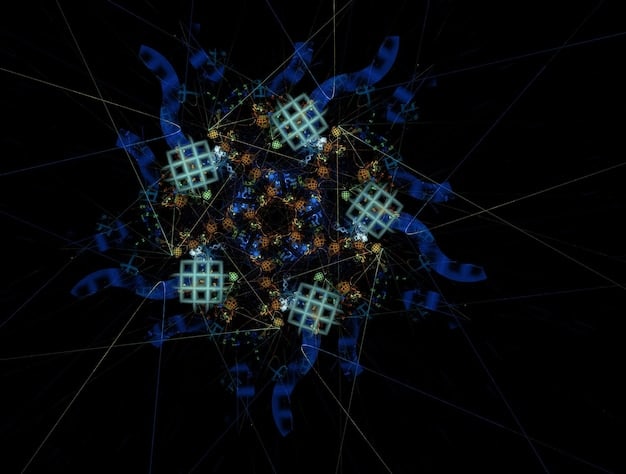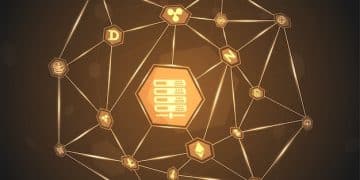Quantum Computing & Data Security: 2025 Predictions for US Businesses

By 2025, quantum computing’s impact on data security will be dual-edged: posing threats to existing encryption while also providing quantum-resistant cryptographic solutions, fundamentally reshaping cybersecurity strategies for US businesses.
The landscape of data security is on the cusp of a dramatic transformation. The rise of quantum computing promises unprecedented computational power, capable of solving complex problems currently beyond our reach. But how will quantum computing impact data security by 2025? This potent technology also poses a significant threat to existing encryption standards, potentially rendering sensitive data vulnerable.
Quantum Computing: A primer
Quantum computing is no longer a distant theoretical concept confined to research labs. It’s rapidly evolving into a tangible force, poised to reshape industries and redefine the boundaries of computation. But what exactly makes quantum computing so different, and why is it such a big deal for data security?
The difference between classical and quantum
Traditional computers store information as bits, representing either a 0 or a 1. Quantum computers, however, use qubits. Qubits leverage quantum mechanics to exist in multiple states simultaneously – a phenomenon called superposition. This, along with entanglement, allows quantum computers to perform calculations in ways that are impossible for classical computers.
Quantum Supremacy and its implications
Quantum supremacy is achieved when a quantum computer can perform a calculation that no classical computer can accomplish in a reasonable amount of time. While still in its early stages, the demonstration of quantum supremacy highlights the exponential increase in computational power that quantum computers offer. For data security, this means that the encryption methods we rely on today could be broken far more easily in the near future.

The exponential computational power of quantum computing presents both opportunities and threats. The implications for data security are profound and require immediate attention from businesses and governments alike.
The vulnerability of current encryption methods
Many of the encryption methods we rely on today, such as RSA and ECC, are based on mathematical problems that are difficult for classical computers to solve. However, quantum computers, leveraging algorithms like Shor’s algorithm, can efficiently solve these problems, rendering these encryption methods obsolete.
- Shor’s Algorithm: This quantum algorithm can factor large numbers exponentially faster than the best-known classical algorithm.
- RSA Encryption: RSA relies on the difficulty of factoring large numbers. Quantum computers could easily break RSA encryption, exposing sensitive information.
- ECC Encryption: Elliptic Curve Cryptography is also vulnerable to quantum attacks, although to a lesser extent than RSA.
The potential for quantum computers to break current encryption methods is a major concern. Organizations must begin preparing now to mitigate this risk, or risk losing the confidentiality of their data.
Quantum-resistant cryptography: The solutions
To address the threat posed by quantum computers, researchers are developing quantum-resistant cryptographic algorithms – also known as post-quantum cryptography (PQC). These algorithms are designed to be difficult for both classical and quantum computers to break. This involves exploring mathematical problems that are believed to be resistant to quantum attacks.
Lattice-based cryptography
Lattice-based cryptography is one of the most promising approaches to PQC. It relies on the difficulty of solving problems related to lattices, which are geometric structures. These problems are believed to be hard for both classical and quantum computers. This approach is gaining traction as a robust alternative.
Code-based cryptography
Code-based cryptography uses error-correcting codes to encrypt data. The security of these systems relies on the difficulty of decoding general linear codes, a problem that is believed to be hard even for quantum computers. It offers a different set of assumptions for security.
Multivariate cryptography
Multivariate cryptography uses systems of multivariate polynomials over finite fields. Solving these systems is known to be NP-hard, suggesting that it is difficult for both classical and quantum computers. While promising, these approaches require careful parameter selection to maintain security.

Quantum-resistant cryptography is essential for protecting data in the quantum era. By developing and deploying these new algorithms, organizations can ensure that their data remains confidential, even in the face of quantum attacks.
Impact by 2025: Predictions for data security
By 2025, the impact of quantum computing on data security will be increasingly evident. Quantum computers will continue to advance, posing a growing threat to current encryption methods. At the same time, quantum-resistant cryptography will mature and become more widely adopted.
Increased awareness and adoption of PQC
Organizations will become more aware of the quantum threat and the need to adopt quantum-resistant cryptography. This will drive increased investment in PQC research and development, as well as the deployment of PQC solutions. Industry wide collaborations with standards bodies such as NIST will accelerate the transition toward quantum-safe algorithms globally.
Hybrid approaches to data security
Many organizations will adopt hybrid approaches to data security, combining current encryption methods with quantum-resistant cryptography. This will provide an additional layer of security, protecting against both classical and quantum attacks. Companies will also use quantum key distribution for highly sensitive data.
- Dual Encryption: Encrypting the data using both classical and PQC algorithms ensures security against known threats.
- Algorithm Agility: The ability to quickly switch between different encryption algorithms provides flexibility.
- Continuous Monitoring: Regularly assessing the security landscape ensures timely responses to emerging threats.
Hybrid approaches represent a practical and effective strategy for navigating the transition to quantum-safe data security.
Preparing for the quantum era: A practical guide
Preparing for the quantum era requires a proactive and strategic approach. Organizations must assess their risk exposure, evaluate their current encryption methods, and begin adopting quantum-resistant cryptography. This is a complex undertaking, but it is essential for ensuring long-term data security.
Assess your risk exposure
Identify the data that is most critical to your organization and assess the potential impact of a quantum attack. This will help you prioritize your efforts and allocate resources effectively. The sensitivity of the data should guide the decision to invest in PQC.
Evaluate your current encryption methods
Determine which encryption methods you are currently using and assess their vulnerability to quantum attacks. Replace vulnerable encryption methods with quantum-resistant alternatives. Organizations must also conduct comprehensive penetration testing.
Implement quantum-resistant cryptography
Begin deploying quantum-resistant cryptographic algorithms in your systems and applications. This will protect your data from quantum attacks and ensure that your organization is prepared for the quantum era. By working with cryptography experts you can ensure that your organization is well prepared.
Taking these steps now will help your organization stay ahead of the curve and protect your data from the quantum threat.
Quantum Computing: Opportunities beyond security
While the impact on data security is a primary concern, quantum computing also offers numerous opportunities beyond security. These opportunities can transform industries, drive innovation, and create new value. This can be beneficial to the consumer and the businesses which utilize it.
Drug discovery and materials science
Quantum computers can simulate complex molecular interactions, accelerating the discovery of new drugs and materials. This could revolutionize healthcare and manufacturing. This field will be able to research and discover new drugs that solve diseases and viruses.
Financial modeling and optimization
Quantum algorithms can optimize complex financial models, improve risk management, and enhance investment strategies. This could lead to more efficient and profitable financial markets. Financial markets will be able to better predict the best times to invest and manage capital.
Artificial intelligence and machine learning
Quantum machine learning algorithms can improve the performance of AI models, enabling new applications in areas such as image recognition, natural language processing, and anomaly detection. Quantum computing offers great potential for these use cases. This will enable new and emerging business trends.
By exploring these opportunities, organizations can unlock the full potential of quantum computing and gain a competitive edge in the future.
| Key Point | Brief Description |
|---|---|
| 🔑 Quantum Threat | Current encryption methods are vulnerable to quantum computers. |
| 🛡️ PQC Solutions | Quantum-resistant cryptography protects against quantum attacks. |
| ⏱️ Impact by 2025 | Increased PQC adoption and hybrid security approaches. |
| 🚀 Beyond Security | Quantum computing offers opportunities in drug discovery and finance. |
FAQ
▼
Quantum computing uses quantum mechanics to perform calculations, leveraging superposition and entanglement for enhanced computational power, vastly exceeding traditional computers. This makes quantum systems ideal for problems that classical systems struggle with.
▼
Quantum computers can break current encryption methods like RSA and ECC using algorithms like Shor’s algorithm, which can efficiently factor large numbers and compromise data confidentiality, presenting a major risk.
▼
PQC refers to cryptographic algorithms designed to be resistant to attacks from both classical and quantum computers, ensuring data remains secure in the quantum era. Lattice-based and code-based cryptography are examples of PQC.
▼
Organizations can assess their risk exposure, evaluate current encryption methods, and implement quantum-resistant cryptography. Hybrid approaches, combining traditional and PQC methods, provide additional security for the transition.
▼
Beyond data security, quantum computing offers opportunities in drug discovery, materials science, financial modeling, and artificial intelligence, driving innovation and creating new sources of value across various industries.
Conclusion
The convergence of quantum computing and data security is inevitable, presenting both challenges and opportunities for US businesses by 2025. By understanding the quantum threat, adopting quantum-resistant cryptography, and exploring new applications, organizations can navigate this complex landscape and thrive in the quantum era.





